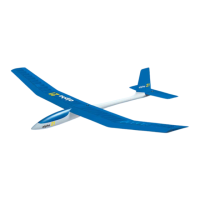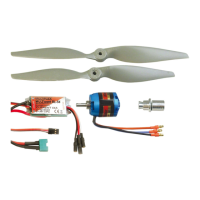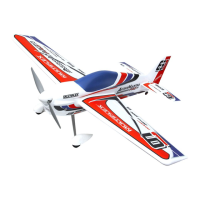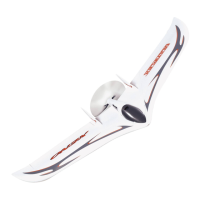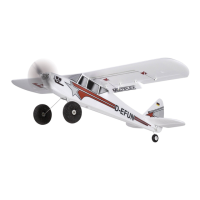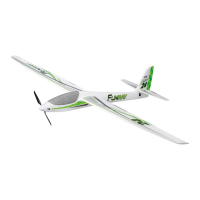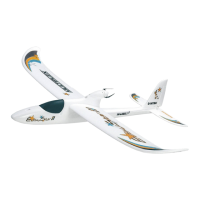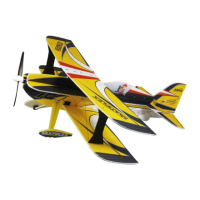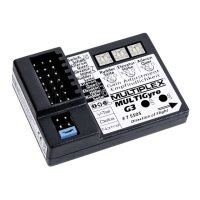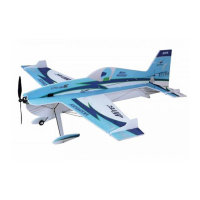The
model can be released
lrom the hand for a winch launch, but a
rise-otf'
ground
is always to be
preferred.
Thisdoes require veryshodgrass,
however,
as
tho
'Alpina's'
slender,
low-dfag
fuselage
does
not
provide
much
ground
clearance.
lf
you
do not have an electric
or rnotor-powqed winch available,
our rubber
tubo bungee
(O./No.
73 2631) can
be used in conjunction wjth a
length
of
suitable
nylon
line
and
parachute.
Place
the model on the
ground,
switch
on the radio, and check all
functions.
Nowyou can
anach the bungeetow
ring!You,oran
assistant,
should
graspthe
fin
and
check lhal bolh
wings are clear ofthe
ground.
Release the
model when
there
is
sutficient
tension on the
line.
lmmediately
after launch the
model is in the most critical
phase
of the
operatjon.
lfthe modelclimbs too steeply,lhere
is
a
riskofthe
airflowoverthe
wings breaking away.
The model will tip-stall, and .apid application of
rudde.
willbe
needed to redress the situation. To avoidthis, applyslightdown
elevator
immediately atter
launch, until the model is in a stable attitude. Now
you
can
gradually
ease in up elevator
to
steepen
the
climb
and increase
your
launch
heighl.
The winch operator
mustwatch the tlexure of the wings at alltimes during the
launch, as this
will
allow
him to
judge
the load on the model, and control the
throttle/swilch accordingly.
ll the winch is
pulling
too strongly, do
not try to
compensate
by applying down elevator, as thewinch operator
will immediately
respond by
making the winch
pulleven
harder. Work out a system of unmista-
keable signs
between lhe winch operatorand
yoursell,
or,
if thewinch is atthe
launch end
(a
return
pulley
is needed
in
lhis case) simply
tell the winch
operator.
Winch and bungee
launching
place
exkemely high loads on the
aircraft
-
especially
in
gusty
weather
-
such
loads
as are
normally only
_,)untered
during aerobatic
flying.
After releasing the tow,
the modelcan be trimmed torstraight
flight. Aim foran
accurato, straight
trim, i.e. with the luselage exactly
in the line
ol
flight. This is
extremely
important il
you
want to extract
ma(imum
performance
trom the
model.
lf the model constanlly
yaws
slightly,
fuselage drag
',vill
be higher, and
the
wing will
produce
less lift as a result ot the angled airflow.
Try flying several
360" turns to
get
used
to the
control
responses, using
clordinated
controls
if
possible.
Every
pilot
develops
his
own
ideas about
control
responses, and
we
can only
give gen€ral
recommendations. llyoufind
one
control too
responsive or too slow, alter the throw accordingly by
moving
the clevis
in
or out
on the servo output arm, or-
with linear
servos
-
wait until
you
can do
it in the workshop.
It is silly to
keep
on
flying for any length of tirn€
wilh the controls set up
incorrectly. On
the other
hand,
oncetheseningF
are correct, do notalterlhem;
the
'Alpina'
is a
high
pertormance
sailplane, and such
models require a fair
amounl ot
praclic€
belore any
pilot
can achieve
its maximum
pertormanc€,
even
when the controls
are kopt at one setting.
lI
you
still
have enough height,
you
can
check iI the
CG
position
is correct
during this
first flight.
However,lhis should
only
be
carried out at a safe height,
so it may well be best to wait until the
next flight.
,,le
simplest and
quickest
method oI checking this
is lo examine the model's
''6haviou|.
in a dive:
this
behäviour
is a Iunction of the
Dosition
of the Centre ol
Lift
relative to the Centre of Gravity at different speeds. This method
represents
a means oI fine-tuning; it will not work if there are
gross
constructional
errors, or
if the CG
is nowherg near
correct.
Apply down
elevator
brietly
and
put
the model into a dive. Releas€ the stick.
lf
the modelis correctly sel up,
itwillpullout
ofthe
dive of itsown accord in a long,
flat
curve
which should nonethelgss be easily
recognizable
as such.
lf the model
immediately
pulls
out and climbs strongly,
the CG is too far
fgnyard. Romove some ballast and apply
a littl€ down elevslor ttim.
It the model
does
not
pull
out at all, or dives rnore and morc
steeply,
immediately extend
the
airbrakes
(if you
have fitted them) and
gently pullthe
modeloutotthe dive.
The
CG
is
too
lar rearward. Add more
balhst and apply a
little
up elevator
trim.
Wo suggestthatyou
alterthe ballast by between
20 and 50
grams
ifyou
areto
see obvious
ditlerences.
Always try to carry out a
'text
book' landing approach.
This means that the
model
should
be tlown downwind at a
height of about 30
m.
at some distanco
from
you.
A
gentle
180'turn willthen bring the
model round heading towards
you
in into the wind. This type of
landing
approach
has the advantagethal
you
are abl€
to
observe
the modelkom the side during
the criticalphasgof landing.
Thiscan be importantduring
competitions, asthefinalturn can
be made',vider
or
tighter to extend or shorten
the approach as required.
ll
you
lind the
model heading downwind at a
low
altitude
on
your
landing
approach,
maintain that heading at all costs.
Tight turns at low allilude
place
your
model in
great peril!
It is in the
finalapproach stage to
landing that airbrakes
really
prove
theirvalue
By using them
you
can controlthe
glide
angle
so accurately
that the modelcan
be
landed exactly where
you
intend. Airbrakes
are simple to use and
easy to
master, and
they allow
you
to start
your
approach
higher, and therelore
shorten
thetime that the
modelis dangerously
close to theground
Brakesar€
also useful
lor aerobatics;
if
you
make a mistake
in
yourllying,
you
can
quickly
reduce speed by deploying
your
airbrakes.
lf the model
gets
too high in a
powerfulthermal, you
can
rapidly and safely
lose
height
byopening
the brakes.
The
'Alpina's'wings
utilize
a Ritz 2 airfoil section
ol varying
thickness. This
section
provides
excellent
perlormance
at high speed,
as well as
good
climbing ability
in thermals.
The combination ol
this airloil
with the low-drag
fuselage and
tailgroup
produces
an ex@ptionally
good
glide
angle ata
higher
basic speed than
is
usual
with scale
models.
These characteristics
mean that the
modeldemands acertain
amount ol
time
from the
pilot
it he is to
get
to know it well- as
do olher
high
performance
models. Even an experienced
pilot
will need a
lew hours with this
model to
really
get
the utmost
trom
its reserves ol
perlormance.
The
main thing to
remember
is
-
don't fly too slowly.
At
the slope the model's wide speed
range in suitable conditions
will thrill any
pilot.
lt
is
well behaved at
low speed, while being capable
oI showing a
clean
pair
ol heels to many models at the other end
o,f lhe speed scale.
lt is highly
manoeuvrable and thus suitable
lor flying on small slopes, but
it is on
Iarge
slopes and
in llat Iield flying that the model really shows
its capabilities,
covering long
distances
efiortlessly ar high speed.
Finally,
a few words on the
subjecr of safety. Always
fly with safety
in mind
Flying a large modei
glider places
considerable
responsibility
on the
pilot.
and
you
can contribute to the success o{
this most interesting
class ol säilplane
by
flying
thoughtfully. Always
tly in
a way
that does
not annoy or endanger
others.
Get to know
your
model thoroughly
over a
period
of
hours, slowly
leel out
the
possibilities
offered by such a model,
and the reward will
be a new dimension
to
your
modelflying.
We would
now like to wish
you
a
lot ol
pleasure
with
your'Alpina',
and many
happy landings.
15
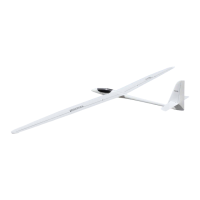
